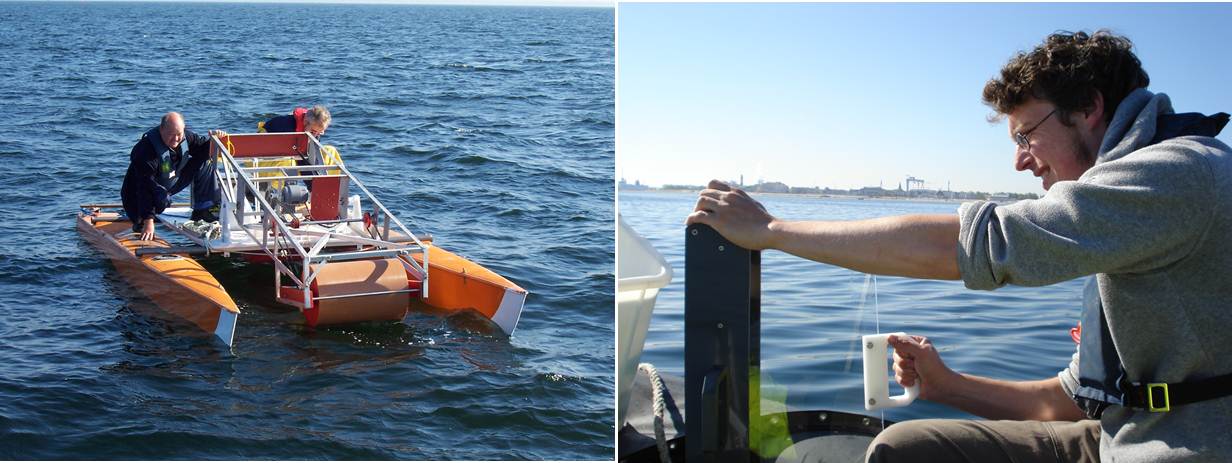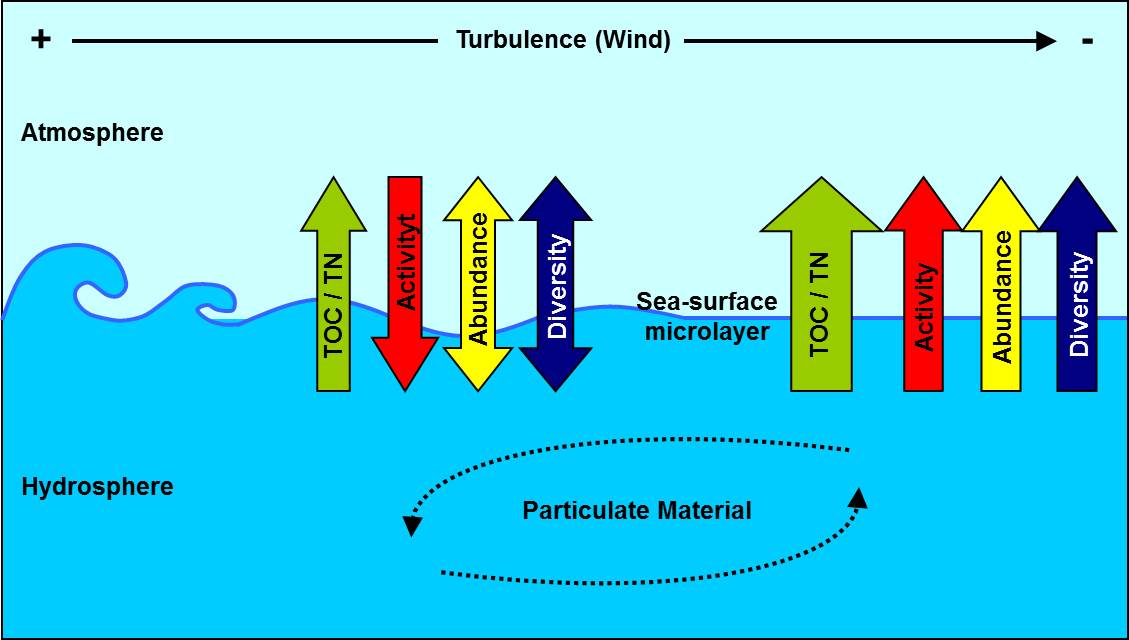
Sea-surface microlayer
The sea-surface microlayer is the boundary interface between the atmosphere and ocean, covering about 70% of the Earth’s surface. With a typical thickness of 40-100 μm, the microlayer has physicochemical and biological properties that are measurably distinct from underlying waters. Because of its unique position at the air-sea interface, the microlayer is central to a range of global biogeochemical and climate-related processes. Recent findings indicate that the microlayer controls globally the interactions between the ocean and the atmosphere. The redeveloped SML paradigm pushes the SML into a new and wider context that is relevant to the ocean and climate science (Cunliffe et al., 2013).
For example, recent studies show that the SML is an aggregate-enriched biofilm environment with distinct microbial communities. A biofilm environment at the air-water interface opens new directions in research on organic-rich aerosols, potentially affecting the formation of cloud condensation nuclei. Moreover, the microlayer is a diffusion layer and slows down the air-sea exchange of climate-relevant gases and heat. The question remains how organisms in the SML might additionally affect these exchange processes.
Although it was thought that the SML is not relevant at typical oceanic conditions, recent studies now indicate that the microlayer covers the ocean to a significant extent. Breaking waves, intuitively thought to be disruptive, promote the formation of a microlayer through ascending air bubble plumes carrying molecules, particles and microbes back to the surface.
Compared to physicochemical analyses of the SML, microorganisms inhabiting the air-water interface have already been studied a century ago. In 1917, Einar Nauman introduced the term ‘neuston’ in order to distinguish organisms inhabiting the ‘skin’ of small lakes from planktonic organisms in the underlying bulk water. Microorganisms are now considered an integral part of the SML and their study is essential to better understand air-sea exchange processes.
Given the strong environmental factors acting on the neuston, e.g. wind stress, solar radiation, enrichment of organic substrates as well as heavy metals and pollutants, this pioneering report already posed the intriguing questions about the specificity of neustonic organisms and their controlling factors, which were continually asked by aquatic microbiologists thereafter:
- How strong do these environmental factors influence the activity of neustonic organisms?
- Do neustonic organisms counteract inhibitory conditions by adaptive mechanisms?
- Can the neuston be differentiated from the plankton by specialized phylogenetic groups?
Additionally, in light of the increasing importance to understand climate change-driven processes, the increasing need for interdisciplinary research and the development of new techniques, e.g. molecular biological tools, recent studies were mainly driven by the question what functional role these neustonic, microbial assemblages have in air-sea exchange processes.

Figure 1: Sampling of sea-surface layer in the Baltic Sea.
In two previous, interdisciplinary research projects FILGAS (surface FILm formation and GAS exchange - funded by the Leibniz Society) and SOPRAN (Surface Ocean PRocesses in the ANthropocene - funded by BMBF), the abundance, activity and diversity of bacterial communities in the SML and underlying waters of the Baltic Sea were compared. Thereby, special emphasis was put on the question how changing physico-chemical conditions (e.g. meteorology, accumulation of organic matter) influence these bacterial assemblages in order to advance our knowledge of potential functional traits of bacteria within the SML. We could show that:
- an appropriate SML sampling technique needs to be critically evaluated for the analyses of desired parameters (Stolle et al, 2009)
- bacterioneuston communities strongly depend on dynamics of particulate organic matter in the SML (Stolle et al., 2010
- bacterioneuston community composition is influenced by prevailing meteorological conditions, especially solar radiation and wind speed (Stolle et al., 2010; Stolle et al., 2011)
- the SML can be considered as a biofilm-like habitat (Wurl et al., 2016)
Thus, the interplay of organic matter accumulation and transformation as well as changing meteorological conditions predominantly influence bacterioneuston communities in the Baltic Sea (Fig 2).
Currently, we try to elucidate how the bacterioneuston community influecnes the export of organic material into the atmorpshere. This work is conducted within the project MarPArCloud and is funded by the Leibniz society.

Figure 2: Conceptual scheme of the interplay between meteorological conditions, particulate material and sea-surface microlayer (from Stolle et al. 2010)
Publications
Oliver Wurl, Christian Stolle, Chu Van Thuoc, Pham The Thu, Xavier Mari; Biofilm-like properties of the sea surface and predicted effects on air-sea CO2 exchange; PROGRESS IN OCEANOGRAPHY; DOI: 10.1016/j.pocean.2016.03.002 (2016)
Luisa Galgani, Christian Stolle, Sonja Endres, Kai G. Schulz, Anja Engel; Effects of ocean acidification on the biogenic composition of the sea-surface microlayer: Results from a mesocosm study; JOURNAL OF GEOPHYSICAL RESEARCH: OCEANS; DOI: 10.1002/2014JC010188 (2014)
Michael Cunliffe, Anja Engel, Sanja Frka, Blaženka Gašparović, Carlos Guitart, J Colin Murrell, Matthew Salter, Christian Stolle, Robert Upstill-Goddard, Oliver Wurl; Sea surface microlayers: a unified physicochemical and biological perspective of the air-ocean interface; PROGRESS IN OCEANOGRAPHY; DOI: 10.1016/j.pocean.2012.08.004 (2013)
Manuela van Pinxteren, Conny Müller, Yoshiteru Iinuma, Christian Stolle, Hartmut Herrmann; Chemical characterization of dissolved organic compounds from coastal sea surface microlayers (Baltic Sea, Germany); ENVIRONMENTAL SCIENCE AND TECHNOLOGY; DOI: 10.1021/es204492b (2012)
Christian Stolle, Matthias Labrenz, Christian Meeske, Klaus Jürgens; Bacterioneuston community structure in the southern Baltic Sea and its dependence on meteorological conditions; APPLIED AND ENVIRONMENTAL MICROBIOLOGY; DOI: 10.1128/AEM.00042-11 (2011)
Christian Stolle, Klaus Nagel, Matthias Labrenz, Klaus Jürgens; Succession of the sea-surface microlayer in the coastal Baltic Sea under natural and experimentally induced low-wind conditions; BIOGEOSCIENCES; DOI: 10.5194/bg-7-2975-2010 (2010)
Christian Stolle, Klaus Nagel, Matthias Labrenz, Klaus Jürgens; Bacterial activity in the sea-surface microlayer: in situ investigations in the Baltic Sea and the influence of sampling devices; AQUATIC MICROBIAL ECOLOGY; DOI: 10.3354/ame01351 (2009)
PhD thesis
Christian Stolle (2010): Microbial characterization of the sea-surface microlayer in the Baltic Sea. PhD thesis Universität Rostock.